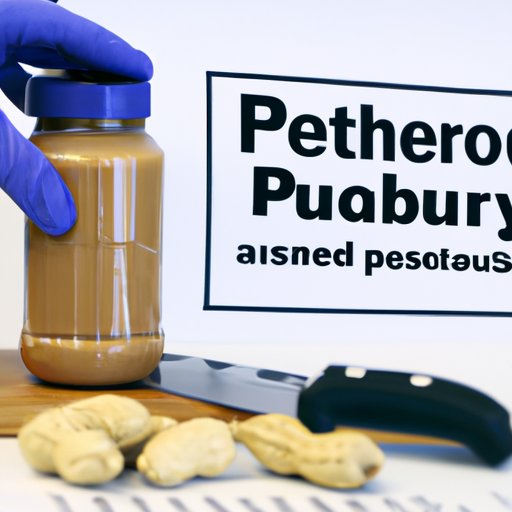Introduction
Salmonella is a type of bacteria that is commonly found in food products, particularly those of animal origin. It is one of the most common causes of foodborne illnesses, with symptoms including nausea, stomach cramps, vomiting and diarrhea. As such, it is important to understand how it can enter food products such as peanut butter.
Peanut butter is a popular food product that is made from peanuts. It is high in protein and vitamins, making it a nutritious snack. However, if contaminated with salmonella, it can cause serious illness. In this article, we will explore the sources and pathways of salmonella contamination in peanut butter.

Exploring the Sources of Contamination
In order to understand how salmonella can enter peanut butter, it is important to explore the potential sources of contamination. This includes examining the food processing procedures and the environment in which the product is produced.
Potential Sources of Contamination
The U.S. Food and Drug Administration (FDA) has identified several potential sources of salmonella contamination in peanut butter. These include raw ingredients, equipment and surfaces, as well as employees’ hands and clothing. Raw ingredients, such as peanuts and other nut products, can be contaminated with salmonella before they reach the manufacturing plant.
Investigating Food Processing Procedures
It is also important to investigate the food processing procedures used by manufacturers. According to the FDA, inadequate cleaning and sanitation of equipment and surfaces can lead to cross-contamination. In addition, improper handling and storage of ingredients can also increase the risk of salmonella contamination.
Analyzing Potential Pathways for Salmonella to Enter Peanut Butter
Once the sources of contamination have been identified, it is necessary to analyze the potential pathways for salmonella to enter peanut butter. This includes examining storage, transport and handling practices, as well as health and safety regulations.
Examining Storage, Transport and Handling Practices
Storage, transport and handling practices play an important role in preventing salmonella contamination. According to the Centers for Disease Control and Prevention (CDC), proper storage of ingredients and finished products is essential for preventing the growth of bacteria. Additionally, transporting foods at the correct temperature and following good hygiene practices during handling can help reduce the risk of salmonella contamination.
Investigating Health and Safety Regulations
Health and safety regulations are also important for preventing salmonella contamination. The FDA requires food manufacturers to have a Hazard Analysis and Critical Control Point (HACCP) plan in place. This plan outlines the steps that need to be taken to prevent contamination, such as regular testing of raw materials and finished products, employee training and appropriate cleaning and sanitation procedures.
Reviewing Quality Control Measures
Finally, it is important to review quality control measures. Quality control measures are designed to identify and eliminate potential sources of contamination. For example, the FDA recommends that manufacturers test their products for salmonella on a regular basis. If levels of salmonella are detected, manufacturers must take corrective action to ensure that the product meets safety standards.
Examining Environmental Factors
In addition to potential sources and pathways of contamination, it is also important to examine environmental factors. These include temperature requirements, humidity requirements and cross-contamination prevention.
Temperature Requirements
Temperature requirements are important for preventing the growth of bacteria. The FDA recommends that peanut butter is stored at temperatures below 40°F to reduce the risk of bacterial growth. Additionally, it is important to keep food products out of the “danger zone” of 40°F to 140°F, as this is the temperature range where bacteria can multiply rapidly.
Humidity Requirements
Humidity requirements are also important for preventing the growth of bacteria. The FDA recommends that peanut butter is stored in a dry environment with relative humidity levels below 60%. This helps to reduce the risk of bacterial growth and spoilage.
Cross-Contamination Prevention
Finally, it is important to prevent cross-contamination. This involves separating raw ingredients from finished products and using separate equipment and utensils for each. Additionally, it is important to clean and sanitize all equipment and surfaces regularly to reduce the risk of contamination.
Conclusion
In conclusion, salmonella contamination in peanut butter can occur through various sources and pathways, including raw ingredients, equipment and surfaces, storage, transport and handling practices, and environmental factors. To prevent salmonella contamination, it is important to follow food safety regulations, such as having a HACCP plan in place and testing products for salmonella on a regular basis. Additionally, proper storage, transport and handling practices, as well as cross-contamination prevention, should be implemented to reduce the risk of contamination.
(Note: Is this article not meeting your expectations? Do you have knowledge or insights to share? Unlock new opportunities and expand your reach by joining our authors team. Click Registration to join us and share your expertise with our readers.)
